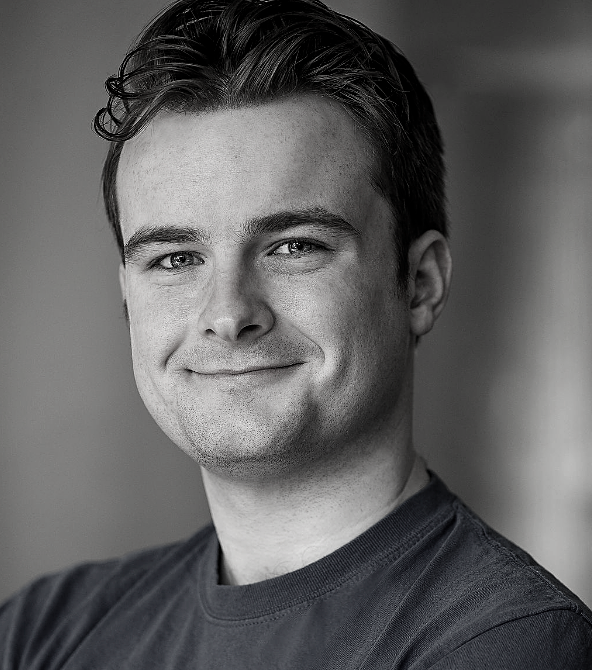REVIEW: her. at Red Sandcastle Theatre is a disquieting experiment with the solo show form
Last September, Canadian Stage’s production of Public Enemy riffed on the popular theatrical setting of the shared meal by giving the audience more to look at than usual: instead of confining the drama to the dinner table, there was action going on in the living room, too.
zippysaid productions’ solo show her., which is being re-mounted at the Red Sandcastle Theatre after a run at the 2018 Toronto Fringe Festival, gives the audience less than usual. Though protagonist Ilsa (Deborah Shaw, also playwright) hosts a light lunch, her guests never appear on stage. Instead, Ilsa converses with air. This surreal concept combines with a highly stylized performance from Shaw to produce an atmosphere that’s disquieting and unique, if not always engaging.
It’s 1954, and Ilsa is a German expat living in Toronto. Her good friend Helga is over for coffee. This would be routine, except that Helga brought along her great-nephew Gunter, who wasn’t invited.
For good reason.
Gunter’s what those in the business of keeping secrets call “trouble”: too young to know that some doors are better left locked, and some highways of inquiry not worth the toll. He’s heard rumours about Helga’s time living in Germany during the Second World War, and wants the truth. He eventually learns it — but if we could see his reaction, it’d probably be nothing but regret for ever asking.
Most of the time, Ilsa acts like Helga and Gunter are there. She pours them coffee, doles out pastries, and directs words at their empty chairs. But Shaw speaks too quickly for it to be believable that Ilsa is talking to anyone: though she responds to things her guests say, she never pauses long enough to have really heard them. This unrealistic-ness — boosted by a sing-songy character voice and a tightly wound physicality — is creepy, and seems to hint that Ilsa is hallucinating or remembering this encounter, not actually living through it (though as with most shows starring invisible characters, Shaw ultimately leaves this ambiguous).
The design — no one specific is credited, but David Agro directs — also gestures towards the surreal. The brightness of Ilsa’s costume, a period-appropriate white dress with red accents, starkly contrasts the Red Sandcastle’s black box interior; and, twice, the lights eerily isolate an empty picture frame hanging on the wall (the significance of which is unclear to me). A few times, a discordant hum faintly plays.
But none of this is enough to push the show into full-on fever dream territory, because Agro’s blocking is often rather realistic (invisible people aside). He has Shaw perform household tasks — cleaning a table, rearranging food — that feel a little too Stanisklavskian for the dreamlike vibe her. seems to be going for. On the other hand, if the show is aiming for something more true to life, Shaw’s performance is too heightened. The production’s tone is inconsistent.
The set reflects this tension. It has some flourishes — a cake stand holding real pastries, most prominently — but is otherwise made up of neutral black chairs and the aforementioned empty frame. The space doesn’t feel truly barren, but it doesn’t quite invoke a specific location, either.
Still, the show’s ending is effective. After Ilsa reveals her secret to Gunter, she retreats into her mind; the lights signify this shift by isolating her in a realm of her own. A repeated phrase, made meaningfully meaningless by Shaw’s chanting of it, gives further weight to Ilsa’s journey into the subjective. Her memories are traumatic, and this moving, highly theatrical climax well captures the dissociative effects that sometimes accompany PTSD.
Considering Canadian theatre’s abundance of solo shows rooted in autobiography, her.’s concept, which seems to be largely fictional, is very welcome. Rather than playing herself, Shaw constructs a complex, three-person period piece all on her own. It’s a daring undertaking, and it occasionally pays off.
That said, I wish the program more clearly explained why Shaw chose to remount her. five years later. Though there are interesting things about the show, there are also issues with it. Shaw’s bio says she has “other works and ideas” she’s impatient to stage; personally, I would be more eager to see those.
her. runs through September 10 at Red Sandcastle Theatre. Tickets are available here.
Intermission reviews are independent and unrelated to Intermission’s partnered content. Learn more about Intermission’s partnership model here.















Comments